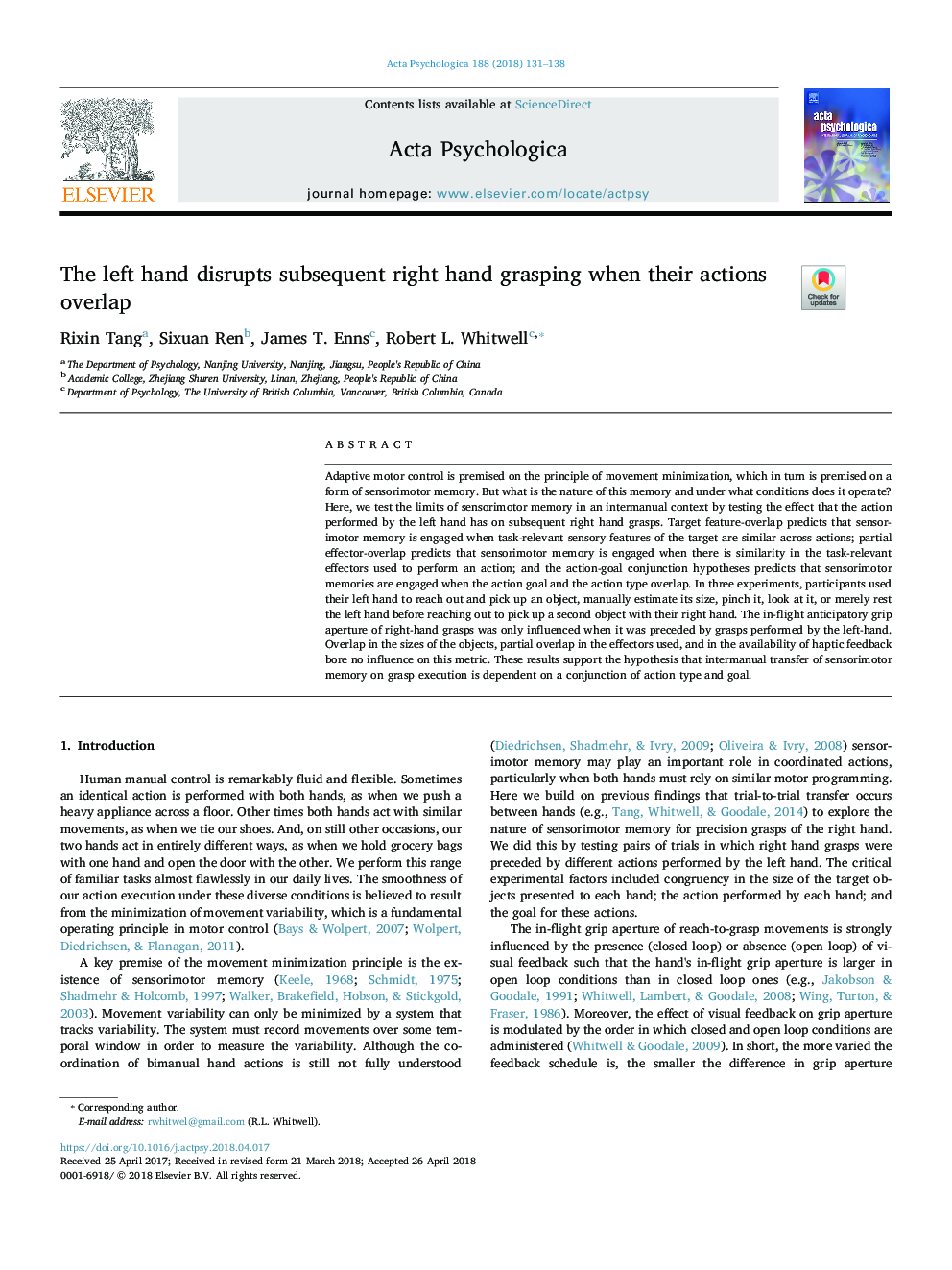| کد مقاله | کد نشریه | سال انتشار | مقاله انگلیسی | نسخه تمام متن |
|---|---|---|---|---|
| 7276608 | 1473570 | 2018 | 8 صفحه PDF | دانلود رایگان |
عنوان انگلیسی مقاله ISI
The left hand disrupts subsequent right hand grasping when their actions overlap
ترجمه فارسی عنوان
دست چپ باعث می شود که دست راست خود را درک کند وقتی که فعالیت های آنها با هم همپوش شوند
دانلود مقاله + سفارش ترجمه
دانلود مقاله ISI انگلیسی
رایگان برای ایرانیان
ترجمه چکیده
کنترل موتور سازگارانه بر اساس اصل کاهش حرکت استوار است، که به نوبه خود بر روی یک نوع حافظه حسگر حرکتی پیش بینی شده است. اما ماهیت این حافظه چیست و در چه شرایطی کار می کند؟ در اینجا، ما محدودیت حافظه حسگر حرکتی را در یک زمینه بینامایی آزمایش می کنیم، با آزمایش اثر که عمل انجام شده توسط دست چپ به دست دست راست دست بعدی است. ویژگی همپوشانی هدف، پیش بینی می کند که حافظه سنسور حرکتی درگیر زمانی که ویژگی های حسی مربوط به کار در مورد هدف در هر عمل مشابه هستند. همپوشانی فیزیکی جزئی پیش بینی می کند که حافظه سنسور حرکتی در هنگام انجام تشابه در کارکردهای مرتبط با کار مورد استفاده قرار می گیرد تا عمل انجام شود؛ و فرضیه پیوستگی عمل-هدف پیش بینی می کند که خاطرات سنسوری حرکتی هنگامی که هدف عمل و نوع عمل همپوشانی دارند، مشغول می شوند. در سه آزمایش، شرکت کنندگان دست چپ خود را برای دست کشیدن و گرفتن یک جسم از دست دادند، به صورت دستی برآورد اندازه آن، خرج کردن آن، نگاه کردن به آن، یا صرفا قبل از رسیدن به سمت چپ دست خود را به سمت راست دست بردارند. چشمانداز دست چپ دست از پیشانی چنگال دست راست دست برداشته شد. همپوشانی در اندازه اشیاء، همپوشانی جزئی در اثرورهای استفاده شده، و در دسترس بودن بازخورد لمسی هیچ اثری بر این متریک ندارد. این نتایج از فرضیه پشتیبانی می کند که انتقال بین مداوم حافظه سنسوری بر اجرای اعداد وابسته به پیوستگی نوع و هدف عمل است.
موضوعات مرتبط
علوم زیستی و بیوفناوری
علم عصب شناسی
علوم اعصاب شناختی
چکیده انگلیسی
Adaptive motor control is premised on the principle of movement minimization, which in turn is premised on a form of sensorimotor memory. But what is the nature of this memory and under what conditions does it operate? Here, we test the limits of sensorimotor memory in an intermanual context by testing the effect that the action performed by the left hand has on subsequent right hand grasps. Target feature-overlap predicts that sensorimotor memory is engaged when task-relevant sensory features of the target are similar across actions; partial effector-overlap predicts that sensorimotor memory is engaged when there is similarity in the task-relevant effectors used to perform an action; and the action-goal conjunction hypotheses predicts that sensorimotor memories are engaged when the action goal and the action type overlap. In three experiments, participants used their left hand to reach out and pick up an object, manually estimate its size, pinch it, look at it, or merely rest the left hand before reaching out to pick up a second object with their right hand. The in-flight anticipatory grip aperture of right-hand grasps was only influenced when it was preceded by grasps performed by the left-hand. Overlap in the sizes of the objects, partial overlap in the effectors used, and in the availability of haptic feedback bore no influence on this metric. These results support the hypothesis that intermanual transfer of sensorimotor memory on grasp execution is dependent on a conjunction of action type and goal.
ناشر
Database: Elsevier - ScienceDirect (ساینس دایرکت)
Journal: Acta Psychologica - Volume 188, July 2018, Pages 131-138
Journal: Acta Psychologica - Volume 188, July 2018, Pages 131-138
نویسندگان
Rixin Tang, Sixuan Ren, James T. Enns, Robert L. Whitwell,
